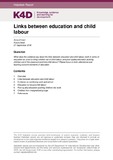| dc.contributor.author | Orrnert, Anna | |
| dc.date.accessioned | 2018-11-01T09:39:16Z | |
| dc.date.available | 2018-11-01T09:39:16Z | |
| dc.date.issued | 2018-09-21 | |
| dc.identifier.citation | Orrnert, A. (2018) Links Between Child Labour and Education, K4D Helpdesk Report. Brighton, UK: Institute of Development Studies | en |
| dc.identifier.uri | https://opendocs.ids.ac.uk/opendocs/handle/20.500.12413/14099 | |
| dc.description.abstract | According to recent estimates, approximately 152 million children were engaged in child labour globally in 2016 (ILO 2017a: 5). There are many forms of children's work, involving different levels of demand and danger. The International Labour Organisation (ILO) defines child labour as work that is detrimental to children, by depriving them of their childhood, their potential and their dignity. Children's work is sometimes distinguished as being hazardous or more benign (e.g., safe and does not undermine schooling), although this distinction is not relevant in all contexts. In some cases, children's work has the potential for both benefit and harm, and assessing harm and benefit in each context may be more useful than applying generalised standards. The worst forms of child labour (as defined by ILO Convention No. 182) are out of scope for this review.
In many cases, work interferes with children's formal education by depriving them of the opportunity to attend school; forcing them to drop out prematurely; or requiring them to balance the competing pressures of schooling and work. Since the launch of the global Education for All (EFA) movement, education is often understood to mean formal schooling. However, this definition excludes non-traditional and informal spaces of learning, as well as significant forms of learning that happen in the workplace.
Many children's rights organisations and anti-child labour campaigns believe that child labour and education are incompatible, that children's work is an obstacle to EFA, that child labour should be abolished and that education is a key element in its prevention. With regards to hazardous child labour, this view is widely accepted. However, there is a counterview which argues that not all children's work is bad, that children's labour can be compatible with education and learning and that work can actually enable education.
This study examines evidence on the links between child labour and education, including the use of education as a tool to bring children out of child labour, poor quality education pushing children out of the classroom and into work, as well as on children who combine work and school. It is one of a two-part series of reports. The second report examines the evidence on short- and long-term impacts of education interventions targeting working children. | en |
| dc.language.iso | en | en |
| dc.publisher | IDS | en |
| dc.relation.ispartofseries | K4D Helpdesk Reports;424 | |
| dc.rights.uri | https://www.nationalarchives.gov.uk/doc/open-government-licence/version/3/ | en |
| dc.subject | Children and Youth | en |
| dc.subject | Education | en |
| dc.subject | Rights | en |
| dc.title | Links Between Education and Child Labour | en |
| dc.type | Other | en |
| dc.rights.holder | UK Government | en |
| dcterms.dateAccepted | 2018-09-21 | |
| rioxxterms.funder | Department for International Development, UK Government | en |
| rioxxterms.identifier.project | K4D | en |
| rioxxterms.version | VoR | en |
| rioxxterms.funder.project | 238a9fa4-fe4a-4380-996b-995f33607ba0 | en |

